Business Intelligence Benefits: Unlocking Your Business’s Potential

On this page:
What is Business Intelligence?
Business intelligence (BI) is a technology-driven process that converts raw data into meaningful information.
This greatly impacts how businesses can plan and make more informed, evidence-based decisions.
It is not just about the tools and software involved but about adopting a mindset that values data as a key asset for growth, especially in the booming data analytics industry.
How Business Intelligence Works
Business intelligence systems are constantly collecting, aggregating, and analyzing data from multiple sources, such as internal databases, customer interactions, and external market data.
Specifically, they empower you to operate in ways that directly support your business goals and enhance your overall business operations.
Business Intelligence benefits organizations by providing the framework for smart data analysis, offering valuable insights into trends and patterns that would otherwise be buried.
The Role of Business Intelligence in Data Analysis
BI tools can work with historical data as well as real-time data, ensuring that businesses have access to relevant data for their decision-making processes.
They further combine in-depth information from third-party sources and synthesize unstructured data like social media behavior.
This enriches the information, providing a full picture of your business performance, market conditions, and customer preferences.
An IDC report found an astonishing 68% of business data never gets used, highlighting the need for effective business intelligence solutions.
Business Intelligence benefits organizations by bridging this gap, providing actionable insights they can derive from previously inaccessible data.
These visualization tools will be paramount in taking that complexity and making it digestible and actionable, ultimately leading to better business decisions.
RELATED: Data Visualization Basics for SMBs
These tools help turn raw numbers into visualizations like graphs, charts, and dashboards that are easier to understand and interpret.
Interactive elements allow you to move past basic dashboards and reports, enhancing the capabilities of your BI dashboards.
You can drill down into specific details and uncover deeper insights that ultimately drive your business results.
For example, e-commerce entrepreneurs can track real-time sales trends, identify high-performing product categories, or monitor customer behavior patterns through dynamic dashboards, making use of business intelligence software effectively.
Types of Business Intelligence: Descriptive vs. Predictive Analytics
Business intelligence includes descriptive and predictive analytics. Descriptive analytics focuses on understanding past and current data to identify trends and evaluate performance.
Predictive analytics employs established trends in past data to predict what is likely to happen in the future, allowing organizations to make informed decisions before events occur.
You can better align inventory with seasonal demand, too. Using BI, you can create more targeted marketing campaigns due to customer segmentation, enhancing your overall BI strategy.
BI isn’t just about reporting. It’s a process involving four key steps: data collection, analysis, visualization, and action.
By simplifying processes and boosting data transparency, BI helps organizations confidently make informed decisions based on clear insights derived from their business data analysis.
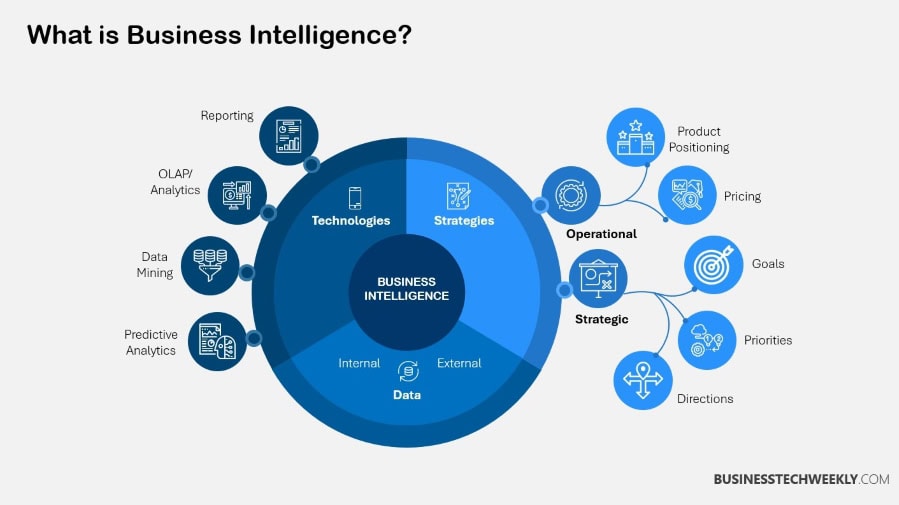
Why Implement Business Intelligence?
Business Intelligence (BI) is a critical asset to organizations looking to fine-tune their decision-making and improve overall efficiency. By employing business intelligence solutions, you can unlock an accurate, data-driven perspective of your organization’s performance.
This gives you the insight needed to make intelligent strategic decisions that best support your mission.
For example, BI tools can analyze historical sales data to identify trends, helping you strategize more effectively for upcoming quarters.
This kind of intelligence makes complicated decisions easier, saving time and eliminating the guesswork.
Business Intelligence for Competitive Advantage
In today’s rapidly evolving business environment, particularly in high-speed sectors such as e-commerce and technology, having access to timely and actionable insights is crucial for gaining a competitive advantage.
With almost 50% of all businesses already implementing BI tools, you might fall behind if you don’t get on board with modern business intelligence practices.
Business Intelligence benefits include helping you better understand the market, identify unrealized potential, and be agile in addressing evolving customer needs.
Spot purchasing patterns and seasonal trends. Armed with this insight, you are able to better manage inventory levels and optimize marketing campaigns to help increase supply to meet demand more effectively.
RELATED: Understanding the Application of BI: 10 Ways Business Intelligence is used
More than just improving performance metrics, Business Intelligence benefits businesses by creating a culture of data-driven decision-making across your organization.
Once all departments from management to operations are using the same accurate, real-time data, collaboration goes through the roof.
This way, decisions are based on facts rather than assumptions. This multifaceted approach works to fortify business practices and ensures the long-term sustainability of these practices through an emphasis on transparency and accountability.
54% of enterprises state that cloud BI is either critical or very important to their current and future strategies.
Without BI, businesses tend to be reactive, missing out on key Business Intelligence benefits that prevent roadblocks and stifled progress.
These obstacles include shoddy data quality, siloed information, and delayed response times to changing market trends.
Without clear, organized insights, your business risks losing out on valuable opportunities, redundant processes, and ultimately, losing the ability to compete in saturated markets.
BI solves these problems by bringing together disparate data sources, improving its accuracy and reliability, and enabling collaboration.
All important features for a growing, fast-paced, and scaling business. BI is an important foundation for more advanced applications. It further underpins smart marketing strategies, improves fraud detection in financial transactions, and aids in developing more precise budgets.
Review your past data as well as live information to make meaningful determinations.
This methodology will sharpen your tactics, streamline your processes, and increase your efficiency by leaps and bounds.
When implemented strategically and correctly, BI becomes more than a tool—it’s your resource for establishing and driving measurable success.
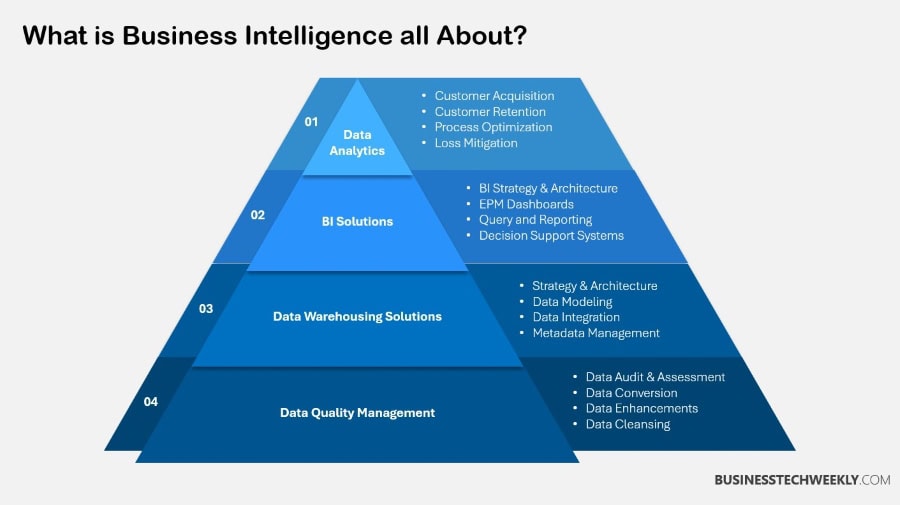
How BI Improves Decision-Making
Business intelligence (BI) is how you start improving your decision-making. It bridges the gap by providing straightforward, easily accessible, and understandable data analysis in real-time.
With BI tools, you can explore the important metrics on demand and in real time.
Optimize your operations and mold strategic and tactical decisions based on real, timely data. Old-school approaches that depend on static reports and lagging indicators only hold you back.
BI puts you in a position to address challenges and seize opportunities immediately.
E-commerce platforms now hook into advanced inventory management systems that track stock levels in real-time.
This strategy not only improves stock availability but avoids over-ordering, minimizes costs, and maximizes customer satisfaction.
Companies with data-driven cultures are 23 times more likely to acquire customers, six times as likely to retain customers, and 19 times as likely to be profitable.
Business Intelligence (BI)—using up-to-date information to shape action in the moment.
Business analytics is all about predicting future trends using more sophisticated statistical techniques. BI provides this bedrock, providing the dashboards and reports that give you better insight into what you’re already doing.
For example, learning that some of your sales regions are underperforming with BI can inform you to shift marketing budgets around.
This hands-on approach makes sure you’re always leveraging your assets in the most productive ways, generating results you can see and quantify.
Traditional versus BI-driven decision-making
Traditional Decision-Making |
BI-Enhanced Decision-Making |
|---|---|
|
Relies on static, outdated reports |
Provides real-time, actionable insights |
|
Decisions based on intuition or guesswork |
Data-driven, evidence-backed choices |
|
Time-consuming manual processes |
Automated workflows and reporting |
|
Limited visibility into operations |
Comprehensive, transparent data views |
With business intelligence giving executives actionable insights, they are better able to see emerging trends in the market and discover new revenue opportunities.
A small business, for instance, might realize through BI that a certain product category gains traction in a specific demographic.
This kind of knowledge can help inform more effective promotions or decisions to expand within those product lines, increasing overall sales and customer loyalty.
BI tools make it fairly easy to uncover new trends that exist in customer shopping patterns.
This knowledge allows you to improve and differentiate your products, helping you beat cutthroat competition in saturated sectors.
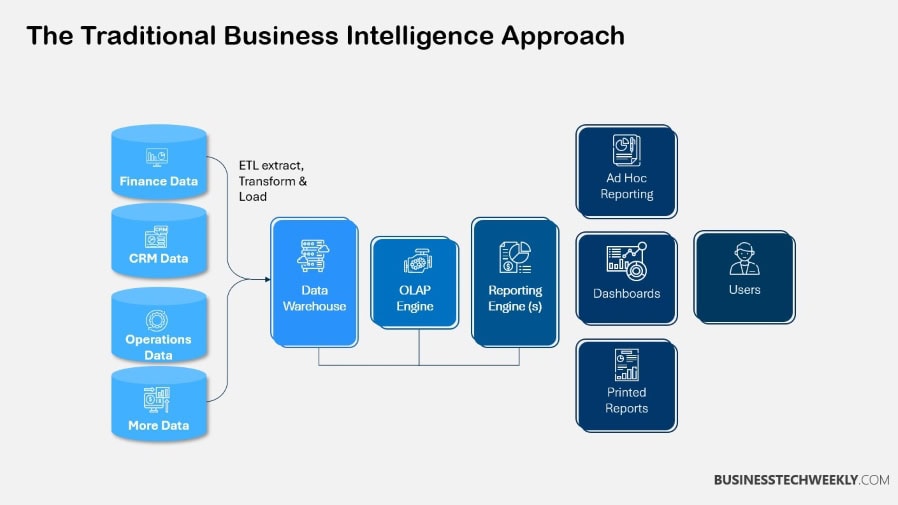
Enhance Operational Efficiency with BI
Business Intelligence (BI) provides a systematic approach for state agencies to optimize operational efficiency by transforming air traffic data into meaningful and timely insights.
Leveraging BI for Performance Improvement
This business intelligence software allows organizations to measure performance against predetermined standards or benchmarks, providing a clearer picture of where performance is lacking and where action is needed.
For example, e-commerce retailers can monitor order fulfillment times or cart abandonment rates, using this data to refine processes and boost customer satisfaction.
This ongoing improvement loop leads to improved results. It’s the only way to make sure that day-to-day operations are tightly focused on executing your organization’s strategic vision.
Analytics plays a valuable role in pinpointing the causes and finding solutions to these bottlenecks.
For instance, in manufacturing, BI tools might identify where there are backups in production processes or breaks in the supply chain. If shipping times are consistently extending, BI can highlight specific vendors or regions causing delays, helping you address inefficiencies quickly and reduce costs.
In addition, with access to near-real-time insights, businesses gain the ability to react more quickly to changes, such as reallocating operations resources or changing procurement strategies.
Becoming a data-driven organization is no longer a luxury—it’s a necessity in today’s competitive landscape.
By aggregating data from various disparate data sources into a single, comprehensive view, Business Intelligence benefits include improved data quality and consistency. This empowers BI teams to make data-driven, informed business decisions using a trusted source of metrics, fueling productivity and innovation.
For instance, a SaaS company could leverage BI to analyze user behavior trends, enabling them to prioritize feature updates that deliver the most value to customers.
Driving Agility and Innovation with BI
Business intelligence improves operational effectiveness. Data-driven strategies promote agility, enabling organizations to get a leg up on competitors in oversaturated markets. BI systems can track a variety of key metrics.
These KPIs might encompass metrics like inventory turnover rates, employee productivity levels, compliance adherence, and customer retention figures.
These metrics give you a comprehensive view of your business health and manufacture opportunities to optimize and grow.
In fact, BI tools take the heavy lifting out of data collection and processing, helping automate workflows and eliminate manual effort.
While providing a cross-departmental analysis, it allows for all teams to be working in tandem toward common goals, creating a more united front operationally.
BI is on the forefront of advanced analytics and AI. This integration significantly increases the ability to deliver predictive insights, enabling organizations to foresee challenges and pursue opportunities.
Given that the BI market itself is growing at 8.7% annual growth, its adoption is an attractive investment in continued growth and long-term resilience.
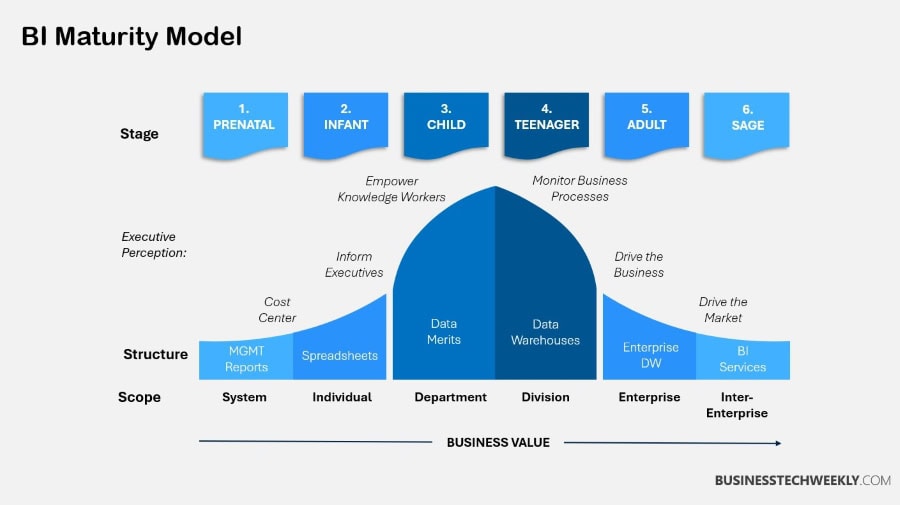
Impact on Data Accessibility and Quality
Business Intelligence (BI) systems, like Tableau or ArcGIS Online, dramatically increase data accessibility while improving data quality. These improvements are a welcome change, indeed, necessary to ensure the best possible decisions in today’s competitive environment.
Through improved data governance, BI protects the integrity of the data you depend on to be the most complete, correct, and credible available.
With high-quality data as the foundation, your team can confidently base strategies on actionable insights, avoiding the risks associated with poor data management.
Enhancing Data Quality Through Governance and Integration
Large companies such as Walmart can be great examples as they write and enforce strong governance policies to help keep bad data out of their warehouse operations.
The ability to combine data from multiple sources is another key advantage of BI solutions.
Many enterprises face the burden of fragmented information stored in silos across various systems, resulting in incomplete analyses and lost opportunities.
BI tools bring together multiple data sources into one, easy-to-understand view of your business. It’s this integration that allows you to find hidden patterns and trends that you wouldn’t be able to identify otherwise. UPS incorporates Big Data into its Business Intelligence environment.
This allows them to get real-time data on fleet performance and improve their delivery routing, a clear example of how more centralized data feeds can improve operational efficiency.
The Role of Centralized Data Repositories in Accessibility
In addition, data lakes and data warehouses improve accessibility by acting as centralized repositories to store accessible structured and unstructured data. Typically 80% of business data is unstructured.
These technologies reduce the effort required to combine information for analysis, enabling new comparisons across unrelated datasets.
This accessibility democratizes your organization’s ability to produce speedy, precise reports. These capabilities significantly reduce the manual labor needed to create traditional reports.
This way, your team has more time to focus on strategic initiatives instead.
Key features of effective BI tools that improve data quality include:
- Automated data cleaning and validation processes
- Intuitive dashboards for easy visualization
- Real-time data updates for timelier decisions
- Scalability to adapt to growing data needs
- Integration with existing systems for seamless workflows
The power of data-driven insights has revolutionized entire industries.
Netflix, for example, harnesses BI to optimize its content lineup according to viewer tastes, keeping offerings timely and appealing.
These examples underline how BI improves data accessibility and positions you to compete effectively in the digital economy.
Measuring BI Success and ROI
Measuring the success of your BI efforts is crucial to maximizing Business Intelligence benefits.
It helps make sure all of this is focused on driving growth and improving your organization’s effectiveness.
By focusing on specific metrics and aligning BI efforts with your overall business goals, you can quantify its value and make data-driven decisions with confidence.
Key Metrics for Measuring BI Success
Developing key performance indicators (KPIs) to use as the baseline for determining BI success is essential. These could be broad organizational KPIs like making better decisions faster, revenue growth, lower OPEX costs, higher NPS, and so on.
You can measure revenue growth that directly correlates to BI-derived insights.
Tracking improvements to operational efficiencies via increased labor hour savings provides tangible proof of effect.
Measuring data accuracy rates and tracking employee adoption of BI tools are crucial first steps.
These steps are key to properly using the solution and getting the most out of it.
Aligning BI with Business Goals for Maximum ROI
Aligning BI goals with your overall business goals is crucial to ensuring measurable ROI.
For instance, if your priority is scaling your e-commerce operations, BI tools can help you identify profitable product categories, optimize inventory, and refine marketing strategies.
When BI outcomes are tied to specific goals, such as increasing market share or improving customer retention, the benefits become more tangible.
Calculating ROI and, most importantly, regularly revisiting those calculations will help you make sure the solution is always delivering value and meeting changing business demands.
Both these case studies paint a picture of what can be achieved through smart and effective BI implementation.
These examples illustrate the tangible financial and operational benefits that can be realized when BI is done well and strategically.
Method |
Advantages |
|---|---|
|
Financial ROI Calculation |
Provides a clear monetary assessment of benefits vs. costs. |
|
Employee Adoption Metrics |
Tracks usability and engagement, ensuring tool effectiveness. |
|
Operational Performance Metrics |
Measures efficiency improvements and cost reductions. |
|
Customer Insights Analysis |
Evaluates customer data for enhanced satisfaction and loyalty. |
To measure BI ROI in the most thorough way possible, you need to use qualitative alongside quantitative metrics.
Quantifiably financial gains are important. Impacts unrelated to cost, like data quality improvement, increased collaboration or employee satisfaction, are just as important to success.
Up to 85% of businesses say they make improved decisions as a result of using BI solutions, showcasing its significance.
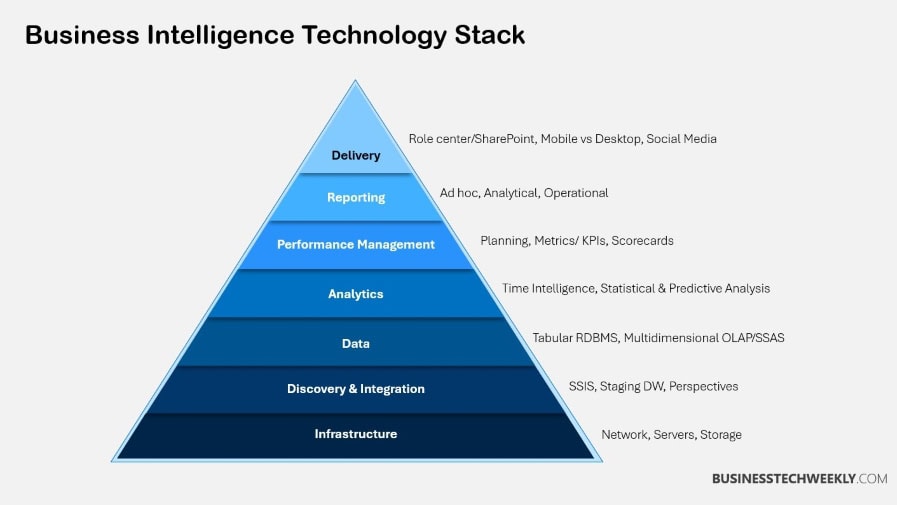
Future Trends in Business Intelligence
The future of business intelligence solutions (BI) lies in accessibility, efficiency, and innovation.
Today, companies have better access to business intelligence software that allows them to analyze historical data. These tools empower them to make one-to-one, real-time decisions that fuel growth.
The transition is evident, as today’s best BI trends are modernizing user experiences, enhancing efficiency, and revolutionizing organizational data strategy.
Empowering Decision-Making with Self-Service BI
Here’s the catch, though—self-service BI applications should be a true paradigm shift for non-technical users. These tools allow entrepreneurs, managers, and team members to access and analyze data without relying heavily on IT or data specialists.
This autonomy accelerates the age of decision, empowering organizations to be agile in fast-paced, changing markets.
For example, a midsize e-commerce retailer can quickly analyze inventory levels based on sales trends using self-service BI.
They can even optimize pricing in real-time, adapting to market dynamics. By nurturing a culture that prioritizes data intelligence, organizations will empower each employee to contribute to developing more intelligent strategies.
AI, Machine Learning, and Cloud: The Future of BI
AI and ML technologies are revolutionizing the field by augmenting BI systems’ data analysis capabilities and improving data processing automation.
Predictive analytics, a branch of BI supported by ML, gives businesses the ability to forecast customer behavior. AI-driven insights fuel hyper-targeted marketing efforts that align with customer interaction trends.
Natural language processing (NLP) is expanding its role beyond customer service, helping businesses analyze reviews, monitor social media trends, and extract actionable insights from text-based data.
That’s because these advancements help BI tools become smarter, more natural, and more effective across all industries.
Cloud-based BI solutions are another rapidly-accelerating trend, providing organizations with real-time access and seamless collaboration.
Cloud BI tools are set to become the primary deployment scenario; by 2025, 80% of organizations will utilize these tools.
They enable remote teams or start-ups spread across geographies to collaborate on bi dashboards in real-time, ensuring the entire organization moves in concert.
Modern BI tools focus on portability, with embeddable widgets integrated into platforms like Salesforce or Google Sheets, making data insights easily accessible.
Future BI trends involve a greater attention to data governance, data privacy, and data security.
Organizations will get better at classifying data, knowing where it came from and how long it should be kept.
BI-as-a-Service (BIaaS) and prescriptive analytics will take off, providing enterprises scalable, highly flexible solutions that can address their challenges much faster and more cost-effectively.
Best Practices for BI Implementation
The most effective BI implementations begin with a solid strategy that fits into your organization’s overall mission.
BI is more than technology. It’s a vital blueprint that brings together people, processes and tools into an effective ecosystem, transforming data into actionable intelligence.
Be it enhancing supply chain efficiency or boosting customer lifetime value through proactive engagement, this step will help BI provide a strong, clear path for solving your business challenges.
Laying the Foundation: Strategy and Stakeholder Engagement
A well-structured strategy ensures that data collection, improvement, and tools are not only aligned but scalable as your company grows.
Consistent, regularly scheduled stakeholder meetings help judge progress and determine where your organization needs to change course or double down efforts to maintain momentum.
Just as critical though, is putting time and money behind training and supporting those users.
As statistics indicate, appropriate training can dramatically improve user confidence and engagement by more than 50%.
Employees from the C-suite down to individual contributors are leaning into a data-driven culture. This change is helping to make their workflows more efficient and impactful.
Building effective training programs not only builds user confidence but gets your team comfortable with BI tools so they can do more with less. Continued organizational support makes underutilization highly unlikely.
When employees are empowered to use dashboards to track sales trends and make quick, informed decisions, they stay ahead of the competition.
This fast reaction increases efficiency all around.
Ensuring Long-Term Success: Flexibility and Scalability
BI systems need to be flexible to changing business requirements. Constantly evaluating your tools and processes keeps you agile and ensures you’re using what’s most relevant to move your organization forward.
As industries change, new data sources or technologies will have to be incorporated.
Scalable solutions, whether cloud-based platforms to cut infrastructure costs or middleware to streamline chaotic data, enable you to pivot without overhauling your entire system.
Synchronizing data across different departments or teams, which may be using various tools or storage formats, adds an extra layer of consistency and accuracy into reporting.
Engaging experienced technical leads or consultants, or even outsourcing BI implementation can further reduce risk and improve long-term success.
To avoid common pitfalls, focus on:
- Setting clear, measurable goals.
- Ensuring data synchronization across tools.
- Avoiding underinvestment in training.
- Choosing scalable, adaptable BI solutions.
Key Points to Note
The benefits of business intelligence extend far outside the boardroom.
Business intelligence benefits organizations by transforming raw data into actionable insights, enabling them to identify new opportunities, address inefficiencies, and monitor growth with concrete data.
- Business intelligence benefits organizations by transforming raw data into actionable insights, helping businesses make informed decisions and strengthen their strategies with both descriptive and predictive analytics.
- Adopting BI means better decision-making, greater operational efficiency, and a lasting competitive advantage through a more data-driven culture BI builds on your organization.
- Business intelligence tools provide actionable insights through real-time data analytics. This allows you to identify trends, discover new avenues for revenue, and respond faster to market fluctuations.
- Business Intelligence benefits state and local agencies by increasing data accessibility and quality. This ensures analytics you can consistently trust by providing data governance and unification across your organization’s data landscape.
- Industry-specific BI applications enable tailored solutions, whether optimizing inventory in retail, enhancing customer service in healthcare, or streamlining supply chain management.
- Measuring BI success requires aligning its goals with business objectives, utilizing KPIs to track performance, and ensuring a positive ROI with effective implementation.

